Although this post compiles Annual cicada sightings from 2008, is some Magicicada Brood XIV talk in the July-May comments. Comments are in reverse order.
Hello Elias,
Unfortunately, I saw no cicadas in Puerto Rico although I believe I heard one. However, I brought back some wasps and nests.
I had seen some pictures of cicadas from Puerto Rico, but I’ll check the website you mentioned.
I hope you have some success in Florida!
Best regards,
Bob
Comment by Bob Jacobson — November 3, 2008 [AT] 5:16 pm
Hello Bob,
Going to Minnesota on business for a few days. No cicadas there. Then to Florida next weekend — possible T. davisi still alive there. This will be investigated.
There is a website on Purto Rican cicadas that I posted to Gerry’s Cicada Forum. I hope that is helpful. I wonder if you would have specimens for trade etc. Would love to see some Puerto Rican specimens.
Highly recommend the Davis collection. Saw 50 T. auletes in one box!! and there are over 30000 specimens in there! Must return soon.
Have a safe trip.
Elias
Comment by Elias — October 24, 2008 [AT] 6:21 pm
Hello Elias,
It looks as if you had a great time all around! It will be neat to see some of your photos!
I visited the Mississippi
State Univ. Entomology Museum. There were quite a few specimens, including many T. resonans and auletes. I tried taking a digital photo of one of the resonans, but I suspect most of the specimens had faded somewhat. There were many rather dark specimens labeled T. sayi that looked like chloromera (with the long tymbal covers).
I thought I heard a male calling in Birmingham (something like chloromera), but I didn’t see nor hear anything in MS or southern AL, possibly due to the arrival of the strong cold front—temps only reached about 70 F, with nights about 50.
I head to Puerto Rico this weekend. Good luck in Florida!
Best regards,
Bob
Comment by Bob Jacobson — October 20, 2008 [AT] 7:05 pm
Hello Bob,
The Davis museum was an absolute blast. So many cicadas, so little time. I spent yesterday in Brookhaven digging up first instar nymphs. It was interesting to see some put up a weak defense by waving their foreleg claws at you from their minute feeding chambers. Snapped tons of pictures of this not often observed period of life.
Going to Florida at the end of the month. Hiopefully T. davisi is still active. Need to obtain some specimens!
Hope all is well in Alabama. Take care
Elias
Comment by Elias — October 19, 2008 [AT] 10:36 am
Hello Elias,
That should be extremely interesting to see the Davis collection. Please give my regards to Gerry; I’ll get back in touch with him sometime after I finish travelling.
It appears the weather will be a bit cool in Alabama, especially when I get a chance to travel around during the weekend, so I won’t hold my breath regarding seeing any cicadas!
Best regards,
Bob
Comment by Bob Jacobson — October 14, 2008 [AT] 2:15 pm
Hello Bob,
No cicadas here. Have to go to Brookhaven one more time to observe first instars. WIll try to look for stragglers next May/June.
Wishing you a lot of luck finding T. davisi. I saw in Beamer’s paper on cicadas of kansas that many species are active into October there. Perhaps Alabama should bear fruit. Cicadas of Puerto Rico should be very interesting.
I am going to the Staten Island Museum tomorrow to view W.T. Davis’s collection. Supposedly over 60,000 cicadas there. Been planning this for a while. Gerry from Massachusetts Cicadas is coming too. Should be a lot of fun.
All the best,
Elias
Comment by Elias — October 13, 2008 [AT] 7:29 pm
Hello Elias,
I haven’t heard any cicadas for a couple weeks now. Other than for finding exuviae in VA and NC, the season is over here.
However, I will be going to AL later this week, and with a little luck I may be able to find at least T. davisi.
In a couple weeks I am going to Puerto Rico, so maybe I’ll see species I haven’t seen before.
Best regards,
Bob
Comment by Bob Jacobson — October 13, 2008 [AT] 4:19 pm
Hello Bob,
Very interesting! Wish I was still hearing cicadas. I was down in Atlantic City this weekend but the weather was very rainy all three days. I am not sure if T. latisfasciata comes that far north but its possible.
T pruinosa and variants appear very similar to T linnei which makes this business confusing! Sometimes that coastal wing margin bend is not as pronounced on a linnei specimen. I know this because I only have linnei here and no pruinosa so I can observe every variety and every smaller nymph turns out to be a T. linnei. There are very subtle differences between T. pruinosa, t. winnemanna and latisfascaiata. I think Kathy Hill gave me a nice summary and I will try to locate that email.
I intend to visit the Staten Island Museum collection which house one of the largest collections in the world put together by the cicada pioneer William T. Davis. That should be very interesting to see.
Take care for now,
Elias
Comment by Elias — September 30, 2008 [AT] 7:02 am
Hello Elias,
This weekend I heard T. linnei in Columbus, and both linnei and chloromera near Loveland (NE of Cincinnati, along the Little Miami River trails). The weather was warm and sunny. On the Ohio State Univ. campus I collected three exuviae, one appearing small enough to be canicularis.
I had a brief opportunity to take a hurried look at the cicadas in the OSU insect collection. I saw specimens that looked exactly like those I have found in NC that resemble T. linnei with a straighter forewing and more blunt tymbal covers, and these were labeled as T. robinsoniana. If this is what I have, then those larger, greener ones are probably T. winnemanna. (Some that resembled them were labeled pruinosa.) In any case, I hope I can spend more time there and with other collections in the near future!
Best regards,
Bob
Comment by Bob Jacobson — September 29, 2008 [AT] 4:34 pm
Hello Bob,
If T. cannicularis is out there thats a possibility. Here in western Long Island all is quiet except crickets and katydids. Out east, T. cannicularis was still calling. I will make one more trip. I need to photograph some more 1st instars and want to dig in an area that has Brood V (very weird location) which is sympatric with Brood XIV in Brookhaven. I hope to unearth some of those mature nymphs. Will keep you updated.
Take care,
Elias
Comment by Elias — September 23, 2008 [AT] 8:08 pm
Hello Elias,
I will be going to Ohio later this week and weekend, so I will be interested in hearing if anything is still calling there. I’ll be in Columbus and in Cincinnati.
Maybe you can check that sight every year to see if you can find larger nymphs!
Best regards,
Bob
Comment by Bob Jacobson — September 23, 2008 [AT] 5:51 pm
Hello Bob,
Here in NY, the cicada activity has nearly ceased. In my area, T. chloromera and T. linnei are the dominant species and I have heard nothing from them.
I went to Brookhaven yesterday with a group of cicada enthusiasts and researchers to examine first instar nymphs. We dug beneath trees in areas that were pretty heavily flagged. I found sifting through the most superficial layer where the rootlets were was the highest yield. In one spot I found 11! Brought a 10X jewelers loupe which revealed the darker eye spots, long antennae, clawlike forelegs, spindly legs and the beak by which they feed. Additionally they have these fine hairy projections all over their body. This is my third time this emergence seeing first instars. This is a stage I have never witnessed before. The loupe helps as they appear very small to the naked eye.
The nice part is that T. canicularis was calling in the distance, a reminder that we are still hanging on to a piece of summer!
Talk to you soon.
Take care,
Elias
Comment by Elias — September 22, 2008 [AT] 4:03 am
Hello Elias,
I captured a male of D. viridifascia at the end of June in S Florida, and heard many others. I don’t know the song of D. olympusa in the field although I have heard it on the websites.
This weekend I went to eastern NC, including Greenville where I heard several T. davisi; they seemed to be calling mostly from loblolly pines (P. taeda). Along the way to the coast from Raleigh I heard a couple T. winnemanna in the Goldsboro area.
Back in Greensboro we found one dead female T. chloromera. Otherwise, I think the season is heading toward the end, although some days are cooler so the remaining male cicadas might not be calling even if present.
Best regards,
Bob
Comment by Bob Jacobson — September 21, 2008 [AT] 7:14 pm
Hello Bob,
I look forward to Florida. I have heard Diceroprocta olympusa and Diceroprocta viridifascia while I was there in June. By looking at the charts of activity on the Northern Florida Cicada site, they can be active into october, especially davisi. That parallels T. canicularis here in the north which persists late in the season.
Will return to Brookhaven possibly this weekend to follow up on the first instars. I was thinking of getting a microscope and viewing the speicmens live to see if I could see the eyes.
Take care,
Elias
Comment by Elias — September 19, 2008 [AT] 7:26 am
Hello Elias,
I should put my hatchlings under a microscope to see if I can see red eyes. However, it’s possible the alcohol preservative may have affected the color.
I heard T. chloromera and davisi today in Lenoir, NC. By the way, I have a female T. davisi collected Oct 9 (1994) in Beaufort Co., NC, although it has rather battered wings; however, this suggests you should be able to find this species in Florida, too.
Take care,
Bob
Comment by Bob Jacobson — September 18, 2008 [AT] 5:19 pm
Hello Bob,
Heard T. linnei and T. chloromera over the weekend. The calling frequency has dropped dramatically. Hoping to go to Fl. in October so I may be able to come in contact with some different species.
I will return this weekend to see the first instars. They are very interesting! They have red eyes at birth too which is cool. I am thinkng of getting a microscope to really study their morphology.
Stay in touch
Elias
Comment by Elias — September 17, 2008 [AT] 4:31 pm
Hello Elias,
This past weekend in Greensboro I heard T. winnemanna, a couple auletes, davisi, robinsoniana, and several linnei. Although I found some exuviae (mainly on the ground, probably fallen from the trees), I found no dead adults. This morning in Lenoir, NC I heard a single chloromera. The activity is slowing down a bit but there there.
All the exuviae I have found in Greensboro were of moderate size—that is, no davisi nor auletes.
By the way, I’m impressed with your having found hatchlings among rootlets, as you had reported earlier!
Best regards,
Bob
Comment by Bob Jacobson — September 15, 2008 [AT] 5:45 pm
There was a Tibicen on my brick wall in Akron Ohio this morning. We had a bad wind storm throughout northeast Ohio. It appeared to be fully grown does this mean they are coming, going or just a fluke? I have a few pictures of it.
Thanks Tony
Comment by Tony — September 15, 2008 [AT] 4:35 am
Last night,my buddy and i caught a 17 year cicada while digging to make a dirt ramp for my bike.
he put it in a 156 gallon tank and he hopes to keep it.
Comment by gavin — September 14, 2008 [AT] 8:33 am
Last night,my buddy and i caught a 17 year cicada while digging to make a dirt ramp for my bike.
he put it in a 156 gallon tank and he hopes to keep it.
Comment by gavin — September 14, 2008 [AT] 8:32 am
Hello Laura,
You can learn a lot on this site. The cicada is a fascinating insect and it was around 5 yrs old that I began my fascination. I am now 35!! Stick with it, and send us some pictures. All the best from NY to MI!
Elias
Comment by Elias — September 9, 2008 [AT] 9:17 pm
Hello again Elias, Thankyou for your help, I took your advice & went to Roy Troutman’s Gallery. It was a Tibicen! Im still very excited. I have only ever been able to hear them never saw one & to share this experience with my 5yr old son who loves bugs of any kind was truly a memorable one. Laura, Springport, MI.
Comment by Laura — September 9, 2008 [AT] 11:50 am
Greetings all:
I am looking for any information on the location of Tibicen auletes on Long Island or Staten Island, New York.
Please review this picture/call of T. auletes. They like sandy soil and oak trees and call mainly at dusk.
http://www.musicofnature.com/songsofinsects/iframes/cicadas/popup_tibiaule.html
Please tell me what town or nearby place you hear them or you can email me directly at epb471 [AT] yahoo.com. The goal is to update nearly 100 year old databases on this elusive species. Thank you!! ELIAS
Comment by Elias — September 7, 2008 [AT] 6:49 pm
Angie,
I kept one for 13 days after emergence. Fresh twigs from hardwood trees should be provided so the cicada can suck the juices from the twigs.
In what geographic area are you finding these?
Comment by Bob Jacobson — September 2, 2008 [AT] 3:04 pm
We have been finding lots of shells and cicadas in our yard. My 4 year old daughter has become quite the enthusiast. We saw one last night crawling in the grass with shell intact and this morning the shell was shed and the beautiful cicada was right next to it! Very cool. How long after they shed their shells do they typicall live and what do they eat as adults? Thanks!
Comment by Angie — September 2, 2008 [AT] 12:11 pm
Hello Elias,
This photo is definitely not of chloromera. I would say it is the “typical” form of lyricen (which, admittedly, varies somewhat, too!). Besides the coloration, the tymbal covers are proportionately much smaller than those on chloromera. By the way, this IS a beautiful photo!
My immediate “objective” is to develop proficiency in recognizing all the species of Tibicen found in the eastern half of the US. After that, I want to learn all the Tibicen in the entire US as well as the Diceroprocta and other genera. This will all prove helpful in compiling distribution records so we can all learn more about where each species occurs.
By the way, I have both my green (virescens?) form and engelhardti in Lenoir, which suggests sympatry. In the University of Georgia collection I saw almost nothing but engelhardti (most from Athens, Atlanta, etc.), just one “typical” lyricen (but unfortunately I didn’t note the locality) but none of the green form.
Best regards,
Bob
Comment by Bob Jacobson — September 2, 2008 [AT] 9:29 am
I noticed a cicada on the side of my home in Sussex County NJ on 9/1/08. It was the size of a small hummingbird, mostly an iridescent green/blue and made a clicking sound when flying away. I have noticed the empty shells around the yard since last year.
Comment by Judi — September 2, 2008 [AT] 8:37 am
Hello Bob,
I have heard that T. lyricen var. engelhardti has a predomiance in certain areas. I have only captured one here in NY so the regular morph is more dominant here.
The one picture I have seen is a mis-identified T. chloromera on Bug Guide. It has a clear ventral brown stripe which chlormera never exhibits. I have been told that this is most likely T. virescens. I think engelhardti has been discounted as a separate species. The terminology in the cicada world is definitely not user friendly! LOL. Tell me what you think of this beautiful pic:
http://bugguide.net/node/view/190626/bgimage
Take care,
Elias
Comment by Elias — September 2, 2008 [AT] 6:00 am
Hello Elias,
Thanks! I try that approach. I’ve collected T. l. engelhardti in Lenoir and I’ve seen specimens from Georgia. I suspect both this and virescens may be distinct species from T. l. lyricen. I never suspected my green specimens could be virescens (although the epithet certainly fits the coloration!) I’ve been unable to find any photos on the internet so far. In any case, I’ll let you know what I find out!
Bob
Comment by Bob Jacobson — September 1, 2008 [AT] 7:46 pm
Hello Bob,
I think linnei have to have that costal margin bend which is an essential element of that key.
I wonder if the larger greener specimens are Tibicen lyricen var. virescens. Not sure if this variety was made a species yet. Lyricen are larger than linnei or pruinosa, have the ventral brown band and have this greenish morph that I think was reported from Florida. Would be best to ask the crew from Storrs with pictures. That is my suspicion. Tell me what you find.
Elias
Comment by Elias — September 1, 2008 [AT] 7:27 pm
Hello Elias (and other interested readers),
I was looking at my collection and I realized something—I have T. linnei (from NC and elsewhere) with their characteristic sharp bends in the costal veins of the forewings. However, I have a few other specimens from NC of similar coloration and size but with lesser bends and rather flatter ends on the tymbal covers in the males, and the latter specimens strongly resemble those I collected in eastern Nebraska and Kansas that were making the “scissor-grinder” calls, so I assume these NC specimens are actually winnemanna. What I’m finding confusing is that I also have some larger, greener NC specimens (more extensively green on the thorax, and with some green on the abdominal segments) that I assume are still another species. These specimens are slightly larger than chloromera but much smaller than auletes.
Can anyone put a name on these larger green specimens, and is my interpretation of the others correct? I can take photos if that will be of help.
Thanks,
Bob
Comment by Bob Jacobson — September 1, 2008 [AT] 7:09 pm
I know the Tibicen don’t hatch in broods, but you would never know it here in the Hyde Park area of Cincinnati. They seem to be everywhere and you can hear their songs coming from every tree in the neighborhood.
I was out for a bike ride this morning and got whacked in the cheek by a Tibicen. Let me tell you, know that I’ve experienced both, that’s nothing like getting hit by a Magicicada. That Tibicen was MEATY. Felt like someone lobbed a rock at my face!
Comment by Tom L — September 1, 2008 [AT] 6:41 pm
Hello Bob,
Very nice!! I am looking forward to my Florida trip as the South appears very much alive. Here in NY, the chloromera and linnei chorus has dropped in intensity. I managed to find a mangled chlormera male on the ground yesterday. Also found a female on its back that appeared to be dying. Put her on a maple sapling and she readily began to feed. As I was leaving, a male began calling at only 4 feet above the ground. Coaxed him into my net and took him home. What a nice surprise. He called 1x in the Butterfly Pavillion. At night searched Morgan’s Park and Crocheron Park, no nymphs. It seems like the season is slipping away. Good luck getting some of those very interesting species! (Robbinsonia, Winnemanna, Davisi are species I have never seen).
Take care,
Elias
Comment by Elias — September 1, 2008 [AT] 3:40 am
Hello Elias,
This past weekend in Greensboro, I heard T. chloromera, winnemanna, linnei, robbinsoniana, and even a couple auletes and a davisi. Late this morning, as I was searching under trees for dead cicadas, hearing several robbinsoniana calling made me feel frustrated! (I have become effectively blind in one eye, so it is nearly impossible to focus on anything sitting in a tree, and even searching on the ground is rather tricky unless there is a lot of sunlight.) I found only a completely decayed davisi and a somewhat battered winnemanna on the ground. Rainy weather made things rot, and then the mowers finished off anything else before I could get out! I’ll try again next week.
However, I found a small number of exuviae that I’m certain weren’t there last week.
The chloromera I found last Saturday died this Saturday.
Best regards,
Bob
Comment by Bob Jacobson — August 31, 2008 [AT] 7:12 pm
Hello Bob,
Yesterday was cool and overcast. 72 degrees and no nymphs. This morning has rained heavily. Hoping there are some more nymphs waiting underground. Heard a few linnei with the “Cold Temperature” call. We shall keep posted. May have to go to FLorida soon so looking forward to that!
Take care,
Elias
Comment by Elias — August 30, 2008 [AT] 1:24 am
Hello Elias,
Last Saturday I picked up a few more exuviae from trees I had examined before, so I believe they are, but I will see if there are any new ones this weekend!
Have a safe one!
Bob
Comment by Bob Jacobson — August 29, 2008 [AT] 1:00 pm
Hello Bob,
I am sorry. I got you confused with Mike from Western PA. He stated that he heard pruinosa in Philadelphia. This is of tremendous interest to me as Philadelphia is closer to NY and I could conceivably make a quick day trip out there.
Do you still have nymphs coming out in NC. Caught 1 T. linnei female yesterday.
Enjoy the labor day weekend!
Elias
Comment by Elias — August 29, 2008 [AT] 12:56 pm
Hello Elias,
Ho, I’ve never heard pruinosa/winnemanna in Philadelphia. I’ve heard (and seen) chloromera and linnei there. I looked back at my earlier messages here but I can’t find a mention of pr/wi in Philadelphia; or did I say this elsewhere? (If I did, I guess I “misspoke”! Please let me know where so I can figure out if I’m going senile!)
This morning in Lenoir, NC I heard chloromera, linnei and davisi. I’ll be in Greensboro this week so it will be interesting to see what I can find there!
Have a great weekend!
Bob
Comment by Bob Jacobson — August 29, 2008 [AT] 10:46 am
Hello Bob,
Earlier you said pruinosa/winnemanna live in Philadelphia. Is this confirmed or no? I would make a trip to hear them Philadelphia is not too far.
Caught a female linnei eclosing tonight. She is hanging out on my finger and just folded her wings into the adult roof like pattern. This never gets old. The amount of nymphs has clearly declined.
Good night,
Elias
Comment by Elias — August 28, 2008 [AT] 6:56 pm
Hello Elias,
The farthest east I have heard pruinosa/winnemanna in the northeastern US would be the ones in Pittsburgh. I don’t recall ever having heard it in NE NJ—that was “chloromera country”. Of course in North Carolina winnemanna is abundant in the eastern part of the state.
I made a mistake in an earlier message—the Maury River goes through Buena Vista, VA—not the Shenandoah.
Best regards,
Bob
Comment by Bob Jacobson — August 28, 2008 [AT] 3:17 pm
Green Grocers are an Australian species. Take a look at Roy Troutman’s gallery of Tibicen cicadas here. https://www.cicadamania.com/gallery19.html
The newly emerged adult, known as a teneral, is usually a beautiful shade of green. They will darken by the morning. Hope that helps!
Comment by Elias — August 27, 2008 [AT] 2:55 pm
I saw what looked EXACTLY like the photos of the Green Grocer you have on this site yesterday emerging from its exoskeleton. It was on a weeping willow tree in my back yard, my son & I watched it for approx 1/2 hour to 45 min. It was the most unusual bright green I have ever seen. I have never seen one emerging only ever saw the exoskeleton. We live in Springport Michigan. Is it possible that this was a Green Grocer???? Laura
Comment by Laura — August 27, 2008 [AT] 9:07 am
Hello Bob,
Heard a cannicularis call out in Brookhaven yesterday. Looking for more first instar Magicicada nymphs but found none. It seems that the hatching process has ended. I really wanted to see the so called “nymnph rain”. I am glad I saw them took lots of video and pictures.
Caught a chlormera yesterday by the Bay. It was cool so surprised he called. If ti wasnt for chloromera I would not be into this hobby. They are the most interactive of the Tibicens. Tried to get him to call with recordings of other chloromera. He performed the starting part of the call but never got into the whole oscillating portion.
No nymphs in the park yesterday. Hope the season is not over. How far east have you heard Pruinosa/Winnemanna?
Be well
Elias
Comment by Elias — August 27, 2008 [AT] 4:37 am
Hello Elias,
I’ve heard canicularis and lyricens in central PA the past few days, and now in Pittsburgh this afternoon I heard lyricens and winnemanna (or pruinosa). The chloromera I collected as a nymph over two weeks ago in Virginia died this past Saturday, so I had kept it alive as an adult almost two full weeks. I have a live male chloromera I found on the ground in Greensboro just before I left for PA. (I also found a headless, but still living, linnei on the ground in Greensboro.) In PA my father was shaving yesterday with a rather loud electric razor and the chloromera (inside a plastic bag with cuttings) started singing along, and stopped after the razor was turned off! Last Saturday I drove on US 60 to the Blue Ridge Parkway, just E of the town of Buena Vista, VA; and heard canicularis near the summit, among pines. Along the Shenandoah River just west of that town I heard winnemanna. Tomorrow I return to NC, but with the rainy weather I probably won’t encounter anything. However, I’ve been collecting almost all the exuviae I’ve been able to find; perhaps I can figure out to identify all the species from them.
I’m glad you are having some luck finding live nymphs!
Best regards,
Bob
Comment by Bob Jacobson — August 26, 2008 [AT] 6:27 pm
Hello Bob,
Captured two nymphs yesterday, Tibicen chloromera and Tibicen linnei. Both females. Cool morning today (70 deg) with few calling. Managed to get a male chloromera to walk into my net and transported him home. I have him in the “Butterfly Pavillion” which is excellent for keeping cicadas. Have to drive east for canicularis. I have seen only one nymph of canicularis eclose that I obtained in Connecticut.
Auletes seems like a distant dream. Maybe next year!
Elias
Comment by Elias — August 26, 2008 [AT] 8:57 am
Hello Elias,
Sorry you’ve had no luck with auletes! In central PA I’ve always noticed that canicularis exuviae are almost always on conifers (I’ve usually found them on cultivated spruces) and the adults seem to sing from them, too. Otherwise, I don’t generally think of conifers as cicada-food!
Good luck to you, too!
Bob
Comment by Bob Jacobson — August 22, 2008 [AT] 9:19 am
Hello Bob,
The staten Island Auletes hunt has been frustrating. Spent time in Wolfe’s Pond Park which is absolutely gorgeous. The linnei chorus was strong but no other species called. Found some smaller exuvia too. May shift my focus back to eastern long island where I heard them and where I found an exuvium last year.
I have to capture canicularis in NY too. They have a liking for pine forests as some literature suggests they dissapear from mixed forests when the pines are eradicated. Found one eclosing in Sleeping Giant State Park Connecticut, just outside, where there were so many exuvia too!! Trying to find an equivalent of that site in NY.
Not too much time left, so hopefully we get what we need before the end of the season. Good luck!
All the best,
Elias
Comment by Elias — August 22, 2008 [AT] 4:19 am
Hello Elias,
I hope you are successful in finding some auletes, preferably a live nymph!
Last year I found a dead adult male in excellent condition in Greensboro. I wish I could find a robbinsoniana!
I’m heading to Pennsylvania again this weekend until Wednesday AM. I’d be happy to find a canicularis adult, either live or dead!
Best regards,
Bob
Comment by Bob Jacobson — August 21, 2008 [AT] 7:43 pm
Hello Bob,
I happened upon an exuvium from T. auletes on an oak tree in Wading River last year. I have searched hundreds of trees in Wildwood Park (the only place I have heard them) and never found one! Found tons of T. lyricen exuvia but no auletes. WIldwood is a unique place as it has sandy soil and there are no canicularis, chlromera and linnei. Now without lyricen, auletes is the dominant species and they sing only at around 8PM. Never heard auletes call during the day.
I have noticed some definite variability in the size of the exuvia. For example I have had some larger chlromera and one just as as small as a linnei. Canicularis are the smallest of the tibicens here.
I am so interested in collecting more auletes exuvia. My goal is to find a nymph and film the eclose process. I will return to the land of Davis (Staten Island) tomorrow. Hopefully I will have some luck. Be well and have a great evening.
Take care,
Elias
Comment by Elias — August 20, 2008 [AT] 8:30 pm
Hello Elias,
I have some evuviae of canicularis and a known chloromera that I can use for comparison with the batch I just collected. I’ve only collected two exuviae of auletes in my lifetime.
I haven’t times the calling period of auletes, but I have heard them about the hours you suggested—approaching dusk. However, as i recall, it has only been for short periods.
Comment by Bob Jacobson — August 20, 2008 [AT] 2:47 pm
Hello Bob,
I have done the same with exuvia. Here in North east Queens County, Tibicen chloromera and linnei dominate. The exuvia for chloromera are larger than linnei. Lyricen is somewhere in between and I hear more of this species further east. Canicularis has smaller exuvia then all the species mentioned and they are found further east as well. Then there is Tibicen auletes. I have been lucky enough to find one exuvium last year in Wading River on an Oak tree. I heard them call at Wildwood Park but no nymphs or exuvia yet. This species has frustrated me. Bob — when have you heard them calling? Here auletes calls between 7:57PM up to 8:30PM sometimes calling for only 3 — 5 minutes and at most a half hour. No specimens collected yet.
Comment by Elias — August 19, 2008 [AT] 8:12 pm
TOday was a great day. Went to Brookhaven along the William Floyd Parkway and found 1st instar nymphs. I went under branches that had evidience of ovipositing (dead “flagged” branches). Then I laid a black material underneath (a discarded garbage bag I found discarded in the forest). I shook the branch and there they were! They are the size of ants and move at a moderate spped. Took lots of nice photos and videos. This is a stage of their lifecycle I had never seen before. They are so small and fragile.
Comment by Elias — August 19, 2008 [AT] 8:08 pm
This past weekend I tried to see how many cicadas and exuviae I could find in Greensboro, NC. In addition to hearing chloromera during the brightest part of the day, there are robbinsoniana, linnei, winnemanna and a few auletes during the evening. By searching around the trees, I have found a few dead males of linnei and chloromera, one of the latter in nearly perfect condition. I completely filled a sandwich ziploc bag with exuviae, but what I would like to know is why I find most of them on the cultivated Leyland cypresses but very few few on the hardwoods. (One Leyland cypress had some 30 or 40 on or underneath it!) I find most of the adults under red maples and especially willow oaks, but the latter are the largest trees there so serve as natural targets. I certainly would like to know which species is on developing on the cypress roots! By the way, all of them are about the same size. In addition, it’s frustrating to hear the robbinsoniana without so far I having found a single dead one!
Comment by Bob Jacobson — August 18, 2008 [AT] 5:57 pm
Thanx Bob for the helpful information I will check that link out..
Comment by Jewells — August 13, 2008 [AT] 4:36 pm
Jewells,
You are probably seeing and hearing specimens of the genus Tibicen, which are the large dog-day cicadas that appear each year during the warmest summer months. You might enjoy checking the Univ. of Michigan website (http://insects.ummz.lsa.umich.edu/fauna/michigan_cicadas/Michigan/Index.html) and scrolling down to the Tibicen section to see photos and listen to their songs to see which species you are encountering!
Bob
Comment by Bob Jacobson — August 13, 2008 [AT] 3:21 pm
Hi,
I just wanted to report in here in Bay City, MI we are getting the green cicada’s emerging eveywhere as of august 13th 2008..We caught the beetle form and it’s tranforming into the beautiful green cicada at this moment ..You can hear them ..They were here last year too..I was wondering if this was a late batch coming out? We also took pictures too to share..
Best regards,
jewells
Comment by Jewells — August 13, 2008 [AT] 10:41 am
Hi Elias,
I haven’t noticed any differences, but I wasn’t aware that there would be any. The hatching took place from thicker living twigs, so they are inherently different from the smaller dried ones. I’ll keep this in mind and see if notice anything of interest.
I just checked Christine’s photos, but I can’t identify the species. Perhaps after the cicada darkens I will be able to do so if she posts more photos.
Yes, it would be fun to collect both of these genera. I’ve found Diceroprocta in S FL and W TX as well, but have collected Okanagana only once—I believe in SE WY (over 30 years ago!). I collected what I believe is Platypedia in NE CA; I’ll have to key it to be certain!
Do you simply snap your fingers, or is there a special way to do it, such as by a snap that isn’t very loud, more of a sliding sound than a crisp snap?
Best regards,
Bob
Comment by Bob Jacobson — August 13, 2008 [AT] 9:22 am
Hello again,
I originally posted from Collieville, TN that I had taken pictures of a cicada emerging, but after doing more reading on this website, I believe the correct term is molting. I’m not sure how to post my pictures on this website, but anyone interested can go to a google page I created to view them.
picasaweb.google.com/Christine1036/Cicada
—Chris
Comment by Christine — August 13, 2008 [AT] 6:53 am
Hello Bob,
I have to make the trip out west to see some Diceroprocta and Okanagana species.
One question, have you seen Magicicada oviposition scars before and after hatching? Supposedly there is a change once they hatch.
Take care,
Elias
Comment by Elias — August 13, 2008 [AT] 3:52 am
A few years ago I was in Las Vegas at this time of the year, and the species that was out was Diceroprocta apache. They vary somewhat in tint. I had the best luck near the Deseret Industries store (as I recall, on the south side of Flamingo some distance E of the UNLV campus), especially on mesquite and similar leguminous trees. I found the best way to capture them was to wait until it was almost dark, and then slowly approach with a hand, not snapping my hand until within a couple inches away—any sooner and they flew off and escaped. I captured a few, put them into a container with some mulberry twigs, and set them up in my lab in NC where they survived for several days.
Comment by Bob Jacobson — August 12, 2008 [AT] 9:42 am
On vacation to Las Vegas, I got out to the edge of town & was surprised to hear & spot cicadas in what basically amounted to the desert! Didn’t get a photo, and now I am kicking myself… But they definitely didn’t look like the midwestern types.
Comment by Randall — August 12, 2008 [AT] 6:24 am
Hello Bob,
Definitely interested in Christine’s nymph too. Hopefully she can upload pictures. Yesterday, amazingly, saw 5 — 6 nymphs eclosing even though it was in the low 70′s. A bit cool for here. There was no dusk chorus because of the rain and cool weather. Filmed the entire eclose process for a T. chlormera female.
Last Sunday I heard a male chlormera calling low. I snapped my fingers to simulate wing flick signaling and he repsonded back. Unlike Magicicada, male tibicens seem to perform wing flick signaling as well. I coaxed him to climb unto my net and undisturbed and lowered him down. I kept snapping my fingers and let him walk from the net to my hand. He called about 5-6 x, then flew. It was an extremely short flight, not the usual long courses, allowing recapture 2x and a repeat of the process. Highly recommned this if you have chloromera in your area. Not enough experience with other species to see if they respond the same way. I do remember as a kid that linnei do the same thing, and they like to walk alot as they call.
Hopefully I can find a nearby area for pruinosa and I will travel.
If tomorrow is nice, may hunt auletes again. I am motivated to capture this species.
Take care and hope you had a safe drive
Elias
Comment by Elias — August 12, 2008 [AT] 1:22 am
Elias,
The hatchings I saw and collected were in Lenoir, NC, not in PA. I only say a few twigs in PA in which oviposition took place (and I watched M. cassini ovipositing in a couple of these). I checked the twigs a little while ago and found no nymphs. However, I would think it would be about time for them to hatch in PA and NY.
I’ve never heard winnemanna/pruinosa in PA. However, I’ve spent relatively little time in the SE corner which would probably be the most likely area, and the limited time I’ve spent there mainly yielded chloromera, with linnei just across the river in NJ.
Yesterday I was driving back to NC from PA, and I heard both canicularis and lyricen at the I-70 E-bound rest area in Fulton County just S of Town Hill.
While travelling, I stopped at the I-81 S-bound rest area in Augusta Co., VA, NE of Staunton nr Mile 232 at 5 PM and checked most of the trees. Along with some empty shells, a live nymph was crawling up a green ash tree, so I took it with me. I checked it at 8:30 PM and a teneral male of T. chloromera had already emerged. (It has now darkened completely.)
By the way, I heard a “scissor-grinder” just a short distance off I-81 Exit 137 near Salem, VA last night.
It would be interesting to learn what species Chris found in Collierville, TN (just SE of Memphis)!
I’d love to learn how to simulate the wing flick signalling! I’ve wondered whether playing recordings of songs would attract females; have you tried this, too?
Bob
Comment by Bob Jacobson — August 11, 2008 [AT] 6:13 pm
Bob,
Well, that means I have to mae a trip out to the emergence sites again. Really hope to see some white specks. DIx Hills is closest but there was not a huge amount of ovipositing there. Brookhaven was by far the largest so will have to check this out. If they are hatching in PA, then NY should be occurring too. Are you still seeing them?
Had some fun with chloromera coaxing them to call on my hand by utilizing simulated wing flick signaling with finger snaps. Also obtained 5 cicada specimens from a large cicada killer lek in a nearby park.
Have you heard any pruinosa out there in PA. Wondering what the farthest point east for pruinosa (or winnemanna) would be so I could hear the “scissor grinder”. Here we have chloromera, linnei and some lyricen. Further east is cannicularis. Also heard Tibicen auletes (finally) out in Wading River.
Great to hear from you and good luck.
Elias
Comment by Elias — August 11, 2008 [AT] 3:32 am
Elias,
I had seen all the adults in this patch of woods, so I checked the twigs. There were some dead hanging ones, but there were also some thicker ones with notches in them that were still alive. Several species of trees were involved, but most were red maple, probably because it is the most abundant at the edge of the woods and has low branches. I just simply looked around the notches until I noticed a couple white specks nearby, so I put a small plastic bag under them and disturbed them just a bit so they dropped into the bag. I did this late in the day, perhaps an hour before dusk because it was cooler, but maybe other times of the day would actually be better.
I also wanted to report that about a half hour ago (11:30 AM EDT) I was walking in a wooded area in Martha’s Park in Lanse, Clearfield Co., PA where it was sunny with relatively low humidity, and I heard a T. lyricen in addition to a handful of T. canicularis. It’s nice to know there is something here in addition to the latter species!
Comment by Bob Jacobson — August 9, 2008 [AT] 9:04 am
Very nice. How and when did you locate first instar nymphs? If the weather cooperates, I will go out to eastern L.I. to Brookhaven and see if I can find any. Also the hunt for T. auletes is on. Hopefully they are emerging in greater numbers now that August is here.
Comment by Elias — August 8, 2008 [AT] 3:52 am
I tried to pose the adult next to a vial with the hatchling. The vast difference in size (and the limited ability of my “old-fashioned” digital camera!) made this tricky, but hopedly the nymph can be seen.
Comment by Bob Jacobson — August 7, 2008 [AT] 6:55 pm
Hello Joe
Can you send a picture of it into the cicadamania website for us to view. It would be interesting to identify the species.
Bob: that is an amazing lifespan. “Refrigerated stasis” is pretty cool. Hope you got the pictures of Magicicada adults and first instars in addition to Magicicada and Tibicen.
Comment by Elias — August 6, 2008 [AT] 4:39 pm
My last Magicicada septendecim male (which was my last living periodical cicada) died last night after over 11 weeks in captivity. I guess the only red eyes I’m going to see for the next 2 years and 9 months (until Brood XIX starts appearing in the Gulf states) will be on human faces!
Comment by Bob Jacobson — August 6, 2008 [AT] 2:45 pm
Joe,
It might be a female. Female cicadas do not make a sound because they have no tymbals. If you look at the underside of the cicada, you can tell the difference—a male has what appear to be two slightly-overlapping “flaps” or tymbal covers while the female lacks these.
Comment by Bob Jacobson — August 4, 2008 [AT] 6:33 pm
To add to my recent post it also does not make ANY sound. It is still alive and for 2 days now I have been home and it has made no sound. Is that irregular?
Comment by Joe — August 4, 2008 [AT] 10:19 am
Hi, I have been fortunate enough to find myself a black, green, and white cicada. I have no idea what to do with it or who to tell…much less who to turn in to and I am wondering if you would know about that?
Comment by Joe — August 4, 2008 [AT] 10:08 am
Hi Elias,
I’m in central PA for the week. I’ve found some T. canicularis exuviae on conifers and have heard a few males, but otherwise nothing very exciting so far.
Comment by Bob Jacobson — August 4, 2008 [AT] 7:53 am
Hello Bob,
Best location on LI was Brookhaven along the William Floyd Parkway. The flagging is really intense too. Close runners up were East Setauket and Coram.
Will definitely look for stragggler next year. I have seen nymphs and the eclose process fro T. chloromera, linnei, canicularis, lyricen and M. septendecim. I am actively searching for auletes and hope to film it. Also want to have a collection of giant exuviae. The only one I found comes from Wading River Long Island last year. I heard auletes there this yeear so the hunt is on!!
Comment by Elias — August 1, 2008 [AT] 3:33 pm
Hi Elias,
I have collected T. davisi in the far eastern part of NC, but this area is quite different. I’ll just keep looking until I can find one!
Regarding auletes, I will keep my ears open! Last year I heard one (in eastern NC) in late afternoon, still a couple hours before dusk. They are uncommon right here although I’ve heard it at least once here.
I only have two large shells—an old one from eastern NC and another I found in Gainesville, FL. The only live nymph I’ve ver seen was a canicularis from central PA several decades ago!
I’m going to be in central PA all this coming week!
One question I have—were any good locations for Magicicada septendecula found this past spring (Brood XIV)? If so, it might be worth visiting next year to look for stragglers.
Cheers,
Bob
Comment by Bob Jacobson — August 1, 2008 [AT] 9:38 am
Hello Bob
Your suspended animation experiments are so cool. Wish I did the same as I would still have Magicicada now. Only got to experience septendecim this emergence. I think you are far too south for canicularis. Davisi reportedly has the same type of call, but a much shorter duration then canicularis. Sound of Insects has good sound files. I never heard davisi yet except here.
What is your experience with auletes down there. DO they call at other times except dusk. What is their activity during cloudy weather? Have you found a giant nymph yet. Here in NY, Wildwood State Park contains T. auletes and I am hunting them!
Take care
ELias
Comment by Elias — August 1, 2008 [AT] 4:24 am
This morning in Lenoir, NC I heard both T. chloromera and T. canicularis (or T. davisi?). This is the first time I’ve heard the latter this year. If I could find a specimen I could determine whether it is canicularis or davisi.
Comment by Bob Jacobson — July 31, 2008 [AT] 4:25 pm
Just an update: my last Magicicada cassini (a female) died last week, but I still have 3 live M. septendecim males. They have been kept almost 11 weeks so far.
“‘Pharaoh’-callers, eyes so red;
But for me you’d all be dead!”
Comment by Bob Jacobson — July 30, 2008 [AT] 3:51 pm
Hello Bob,
Yes, pruinosa in the east is called winnemanna. I am confused if the species is called Tibicen pruinosa winnemanna or Tibicen winnemanna. The terminology for the annuals is very cumbersome and confusing!! I also believe there is another variant — latisfasciata. I think this is another pruinosa type. I am wondering if this exists in Western westchester county. I think Orange COunty NY had some Okanagana too. More driving for me!!
Comment by Elias — July 24, 2008 [AT] 8:16 pm
Elias, I was told by John Zyla last year that the “pruinosa-equivalent” in NC is properly named winnemanna. It has what sounds to me to be the same call as pruinosa I have heard in Nebraska and other areas.
Comment by Bob Jacobson — July 24, 2008 [AT] 2:57 pm
Annie, last year at Fort Mott State Park I heard chloromera and linnei, so you might have these in Mt. Olive, too.
Comment by Bob Jacobson — July 24, 2008 [AT] 2:54 pm
They didn’t WAKE me up this morning, but at 8:55 am I pity anyone trying to sleep in! These critters in Mt. Olive, NJ are really crankin’ it up! I remember my ex telling me (in 1980) that these NJ ones are SEVEN-year cicadas… it does fit the year??! (don’t know the species..)
Comment by Annie — July 19, 2008 [AT] 5:57 am
Here in NY hearing only T. chloromera and T. lyricen. T. linnei has not made its appearance yet and have to go further east for canicularis. Not as much fun as NC!
Comment by Elias — July 18, 2008 [AT] 10:15 pm
This past Friday night I arrived in Greensboro, NC about 7:30 PM to be treated to the “rasp…rasp..rasp” of T. robbinsoniana, the “chee-chee-chee” of T. chloromera, the “ZOO-eee, ZOO-eee, ZOO-eee” of T. winnemanna, the “zizz-zizz-zizz-zizz-zizz” of T. linnei, and the “durr-durr-durr” of T. auletes. What a nice greeting upon arrival!
Comment by Bob Jacobson — July 13, 2008 [AT] 6:45 pm
Anyone reporting T. auletes yet??
Trying to find a sound file on T. winnemanna
Comment by Elias — July 12, 2008 [AT] 8:44 pm
Just when I got used to the silence after the departure of Brood XIV, over the past 2-3 days I’m beginning to hear the sounds of Tibicen in the trees here in eastern Cincinnati. Quite a busy summer for cicadas!
Comment by Tom L — July 12, 2008 [AT] 7:34 pm
Last Sunday (July 6) I heard T. winnemanna singing in Greensboro, NC. Today I heard T. chloromera in Lenoir, NC—the first Tibicen I’ve heard here this year.
Comment by Bob Jacobson — July 10, 2008 [AT] 4:00 pm
3 — 4 T. chloromera calling in Bayside Queens every morning. Have not heard T. linnei yet. They usually appear a little later.
Comment by Elias — July 10, 2008 [AT] 3:31 am
Tibicen lyricen heard calling in New Hyde Park,New York. Summer is here!!!
Comment by Elias — July 6, 2008 [AT] 7:52 pm
Hello all,
I heard my first Tibicen linnei & Tibicen chloromera today while working on landscaping in our front yard. I also found my first annual cicada nymph tonight (probably a chloromera). Looks like the annual cicada season is getting started here in Southwest Ohio.
Comment by Roy Troutman — July 6, 2008 [AT] 7:33 pm
Hi,
I live in Utah…I have never, ever seen a cicada in Utah before. I am from NC originally and i suspected when i heard it and saw it what it was. After we looked it up on this and other websites, we are sure that it is a cicada. I dont know what kind, but we have pictures and a captured one. It has black eyes though. Not like these on your site. I dont know too much about them, except no one in Utah knows what I’m talking about. Is this Weird?
Comment by Adrienne — June 26, 2008 [AT] 7:38 pm
Hello Maria,
The one your son found may be a straggler. This means that due to an internal clock error or the young cicada’s nutritional state, some may emerge a year later than the rest.
This phenomenon is well known. Some can emerge a year early, a year later, 4 years early or 4 years later. Hope that helps. I will be looking for signs of stragglers next year here in NY.
Comment by Elias — June 26, 2008 [AT] 4:25 am
Hi,
We got hit last year with the 17-yr. cicada in the Chicagoland area. We had thousands in our yard alone. Can someone tell me why my son found one two days ago? It is EXACTLY like the ones that invaded our yard last summer???
Comment by Maria — June 22, 2008 [AT] 8:13 pm
Just spent the weekend on Cape Cod, Mass. After pulling off the highway we opened the car windows and heard this loud sound, My first thought was the fan belt was squealing,so I pulled over and shut off the motor. It turned out to be the noise from the cicadas. When we got to the cottage the noise was even louder. They do get quiet at night and start up again at sunrise. There are literally millioms of holes in the ground and the trees are covered with there shells. They fly around but are no bother to people. The seagulls seem to eat them in flight. Word is they only last a couple of weeks.
Comment by chuck — June 22, 2008 [AT] 3:59 pm
I heard it before I saw it. I live in San Jose, California. I have never seen one before but my neighbor is from Arizona and she had seen them before. My sister moved to Maryland a few years ago for the ’emerging of the cicadas’.
Comment by Eileen — June 17, 2008 [AT] 10:36 am
Parts of Long Islands N/Shore are covered. These guys are friendlier than the green ones—very social—fly right over and land on you !!!
Comment by Heather — June 15, 2008 [AT] 4:40 am
Here in Central Texas we are finding the species “Superb Green Cicada Tibicen chloromera (Walker)” doing their usual Cicada rituals. They’ve got a nice green color and are such an interesting insect to check-out up close — though I’m the only one, between my kids, who will do so! 😉 Though how the Cicadas, around here, can stand the 100 degree temp’s around here is beyond me..
Comment by Heidi — June 15, 2008 [AT] 1:48 am
RB — sounds like a species of Okanagana. There are a few and they sort of looks similar, but fit your description.
Comment by Dan — June 14, 2008 [AT] 5:11 am
Can anyone tell us what sort of cicadas we have here in Northern Nevada — they are black with red legs and red stripes on the lower abdomen, but eyes are dark and not red like periodical cicadas we have seen in books? (Apart from the eye color, they look identical). They’re just coming out now en masse — pretty amazing. Never seen them before…Would love to know what they are…
Comment by RB — June 13, 2008 [AT] 11:15 am
I was at French Park in Cincinnati on Sunday June 8th and saw a whole bunch of red-eyed cicadas coming out of their husks nad flying around. Amazing!
Comment by Natalie Galluccio — June 9, 2008 [AT] 7:59 pm
There are lots of cicadas in Lexington, Kentucky. How long will they remain above ground and noisy? Days? Weeks?
Comment by Barbara Christensen — June 9, 2008 [AT] 3:11 pm
I live in southeastern Idaho and we have some property down in Rockland outside of American Falls. We were there this weekend and were surprised to find cicadas! I lived in Maryland during the 2004 17-year Magicicada emergence. These Idaho cicadas are much different with black eyes and are a bit smaller.
Comment by Beth Watson — June 8, 2008 [AT] 10:42 pm
I live in a rural area of Pa.and the sound of the cicadas is so loud. We can’t even enjoy sitting out on our porch swing.
There is trees covered in shells and cicadas. I can’t remember seeing or hearing them this much.
And I’ve lived here for 35 years.
Comment by Yvonne — June 8, 2008 [AT] 7:37 am
I failed to mention that we are just outside of Asheville, North Carolina. Does anyone know approximately when we can expect to see the cicadas exit ?
Comment by Jeff — June 5, 2008 [AT] 7:30 pm
My wife and I worked very hard planting a large and wonderful variety of trees on our two acre property over the last three years. We had moved here from Florida, and knew nothing about the 17 year hoard of cicadas. We feel sad and powerless watching the destruction being wrought to many of the beautiful trees. Unfortunately, the Japanese beetles will arrive soon with their leaf eating rampage. Combined with the extremely hot weather, the trees will be under terrible strain.
Comment by Jeff — June 5, 2008 [AT] 7:19 pm
Here in Harrodsburg Kentucky, they are thick…..for a Californian that just moved here last year….this is more than I can handle…..the incessant buzzzing sound is driving me crazy & there is no way to escape it. They are swarming around my house…not just on the trees. I own 10 acres with woods, which is probably why it’s so bad…..I have never seen anything so horrible yet fascinating in my life
Comment by Deborah A Klinkner — June 5, 2008 [AT] 1:34 pm
Hey i want to learn more about the Tibicen chloromera — swamp cicada can any help me find more info on them all i can find is pics! slowjamcdub [AT] yahoo.com
Comment by Chris — June 1, 2008 [AT] 6:38 am
I was wondering if anyone could tell me if the Cicadas have come out in the Louisville area yet?
Comment by Karla — May 27, 2008 [AT] 7:15 am
Brood 14 running strong right up against the Smokies. Numbers diminish signifacantly as you move away from the mountains
Comment by Dan — May 26, 2008 [AT] 3:25 pm
East Tennessee is in full swing for about 9 days now. Noise is less than previous brood 14.
Comment by Dan — May 26, 2008 [AT] 3:23 pm
Cicadas are showing up here in Indian Hill, Ohio. Found them on the apple tree and the maples out front. We haven’t seen enough to be a nuisance yet, but there were many 2 years ago, whatever brood that was (not a fan of the little critters, but the homeschooled kid loves them!)
Comment by Trenton — May 26, 2008 [AT] 2:50 pm
FAIRVIEW NC MANY MANY
Comment by DANE — May 20, 2008 [AT] 8:14 am
They’ve been out here in force for about two weeks. When I woke up the other morning, I thought a tornado alarm was sounding…the woods behind our house were so loud. At first they’re interesting, but when you sweep about a hundred a day from your back deck, they become pretty gross. If I understand correctly, they’ll be around till about July. Right?
Comment by Doug Mills — May 19, 2008 [AT] 11:38 am
Phoebe is back!
Comment by Dan — May 14, 2008 [AT] 10:17 am
I heard several more cicadas yesterday evening around 6:30 PM in Sacramento, CA. They were all on one city block. I guess our annual cicadas emerge at the same time as the 17-year ones in the eastern half of the country.
Comment by Phoebe — May 14, 2008 [AT] 5:00 am
I believe I heard our first Northern California annual cicada of the season on Sunday, May 11 in Sacramento. It sounded like one of our usual Okanagana types. I have only heard one so far, but I expect the rest to start emerging in the next 2 weeks.
Comment by Phoebe — May 13, 2008 [AT] 3:55 am
A note from a cicada fan in Sydney in response to the previous 3 Aussie cicada comments. The large “black guys” from New England may be ‘cherrynoses’ (Macrotristria angularis) as these don’t emerge every year, but they are slightly smaller than double drummers (which is our largest). I remember my childhood cicada hunts and they impressed me as “larger than life” at younger ages! I have also been collecting in the NEng region over the past 10 years and haven’t found anything larger. BUT cicadaphiles have recently found new (large) species of double drummers (Thopha saccata) and cherrynoses so in this vast land, we must always be open to new possibilities for species. We had massive emergences of double drummers in coastal NSW in Nov 2006/7. The Blue Mtns west of Sydney has around 15 endemic cicada species, most small to medium, with huge numbers of “Masked Devils” (green grocer variants) emerging in October 2007 from Woodford to Blackheath- fantastic numbers.
Jodi posted some great shots of Thopha colorata on cicadamania.
Season is pretty well finished in Sydney due to unseasonally heavy Feb rains- only the usual few lonely black prince males still trying to call up a female until around Easter.
Good luck in the USA with the periodicals from May 23.
Comment by david — March 13, 2008 [AT] 2:49 pm
Hello fellow cicada lovers. Just posting this to “get the word out there” to a receptive audience.
When I was a kid I caught cicadas every summer like any other kid. In Sydney, Australia, it was mostly greengrocers, the occassional yellow monday and black prince.
But when I went on holidays to the New England area of New South Wales, one year I found MEGA cicadas — these guys were at half the size again of those I caught back home.
I didn’t think much of it except “how awesome!” and “I wish the kids in the street back home could see me with these guys!” until I came across a magazine article which illustrated the largest of many of Australia’s insect specimens. It listed the double drummer and I thought — oh, that’s a mistake; they’ve obviously forgotten about the ones I found as a kid.
Later, I came across a similar poster, this time at the Australian Museum and I thought — hang on a minute — perhaps they don’t *know* about the big ones I caught as a kid.
So I asked, and they walked me into the exhibit, pointed at a cicada and said “there — that’s as big as they get”.
I said “No. The ones I caught were half that size again.”
They said if I ever found them again to bring one back.
So that’s where it’s at. I’ve looked once since (because I rarely visit the area anymore, let alone at the right time of year) and let a few locals know to post me some if they turn up again.
Now — to the cicada fanatics — what are the odds this is an annual? Does Australia have “cyclic” cicadas (ie, don’t emerge every year)? How long would an emergence likely be?
I think I know the answer to all three questions seeing as I’m talking about a species no-one else knows about.
Oh, and from memory, they were mostly black with a few green ones. This tidbit alone might suggest I recall it all incorrectly — unless you can tell me there *are* species which emerge in two or more colour forms. (Is the yellow monday the same as the greengrocer?)
Anyway, that’s that. The trees, road and paddocks are all still there, so here’s hoping.
Cheers,
Chris.
Comment by youcantryreachingme — January 2, 2008 [AT] 1:17 am
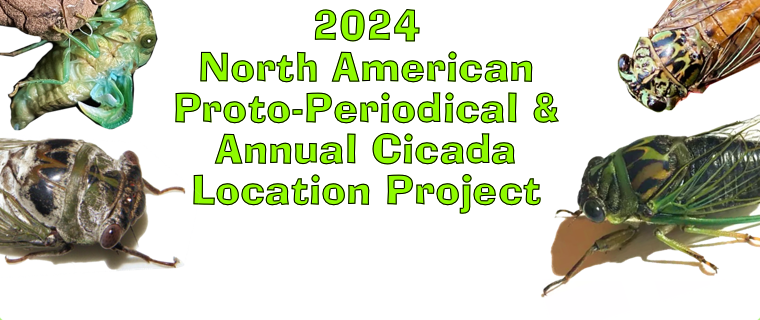
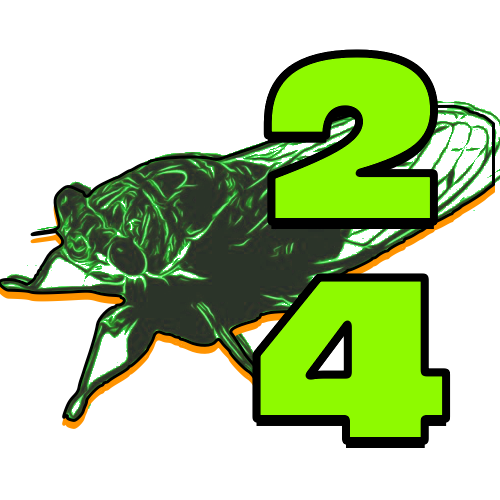

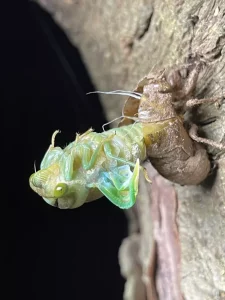
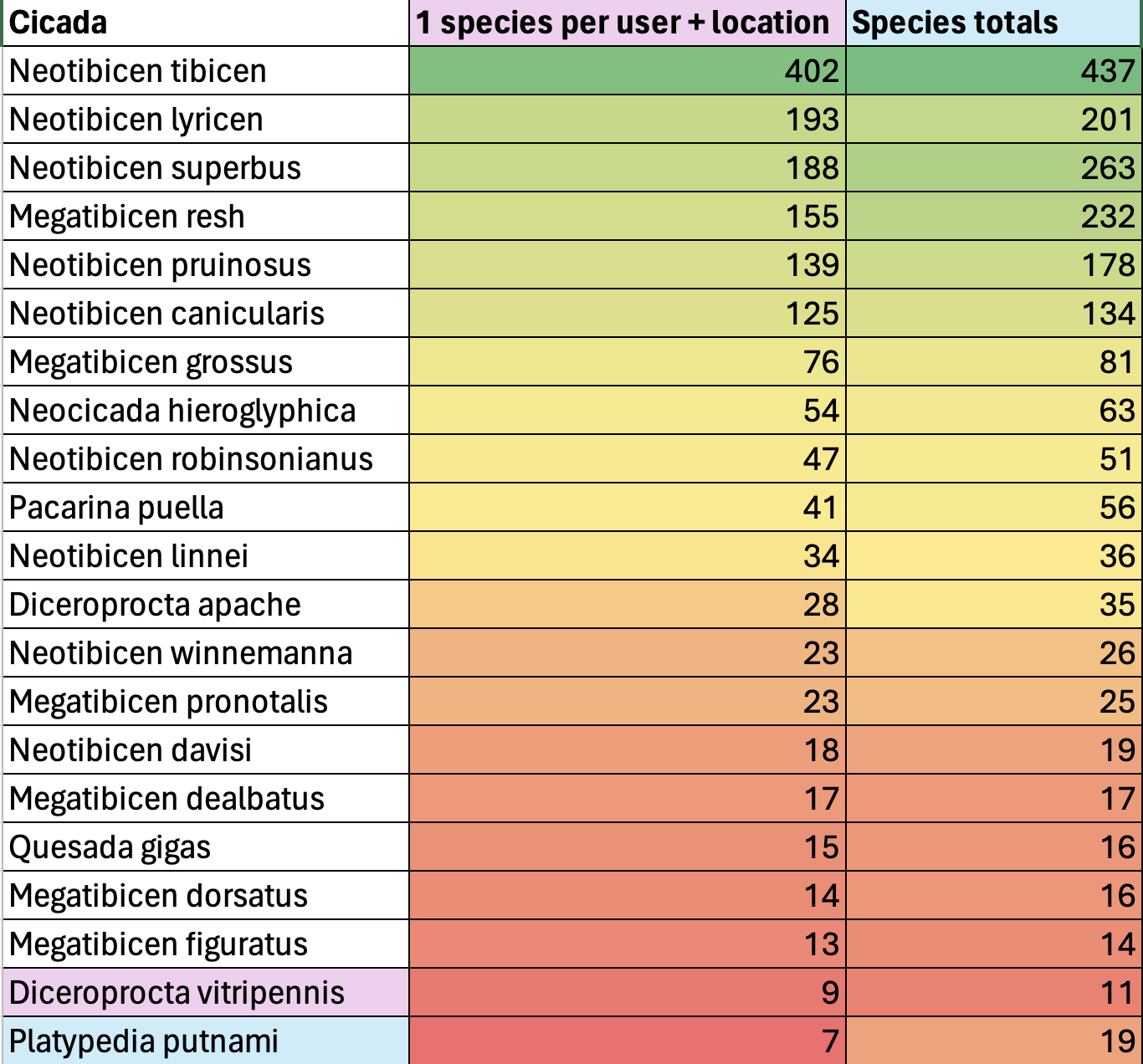
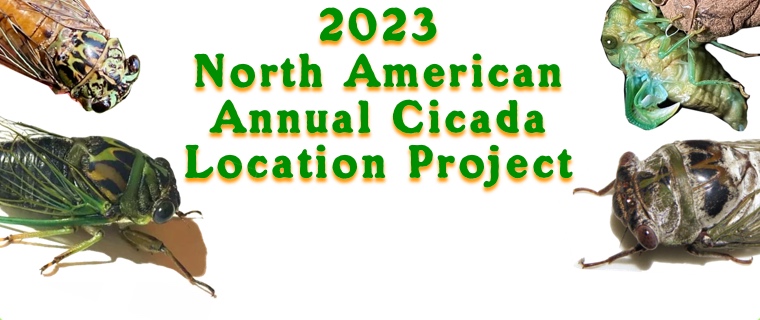
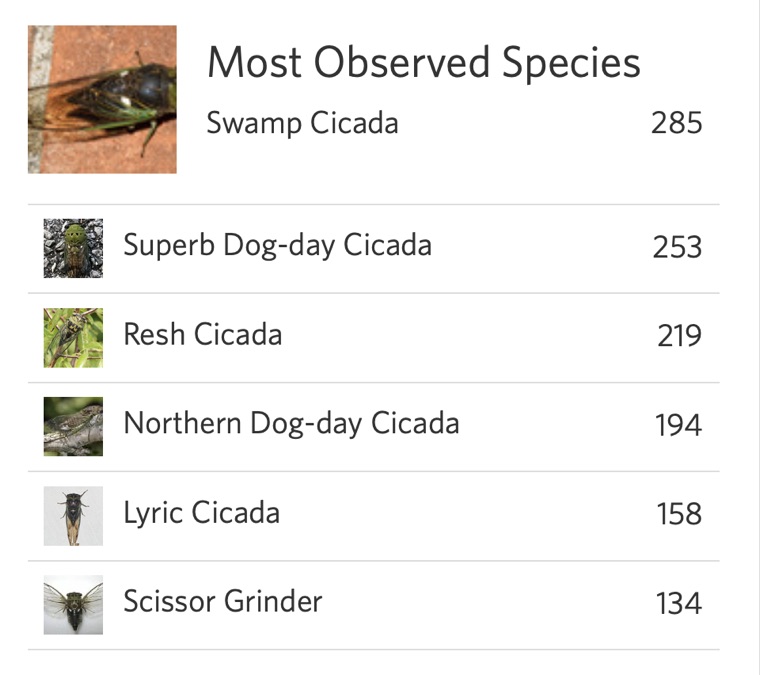
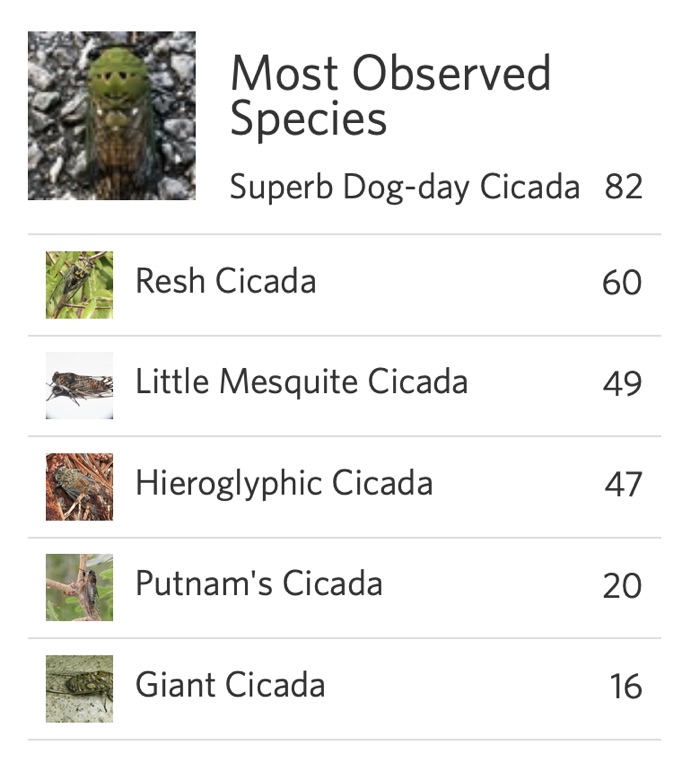
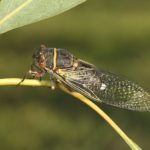
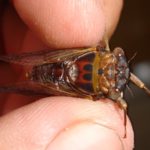
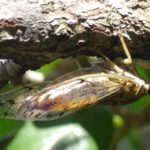
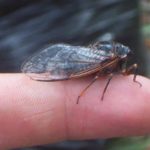
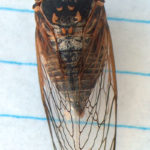
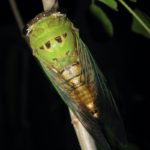
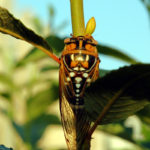
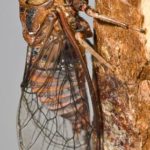
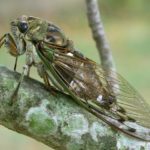

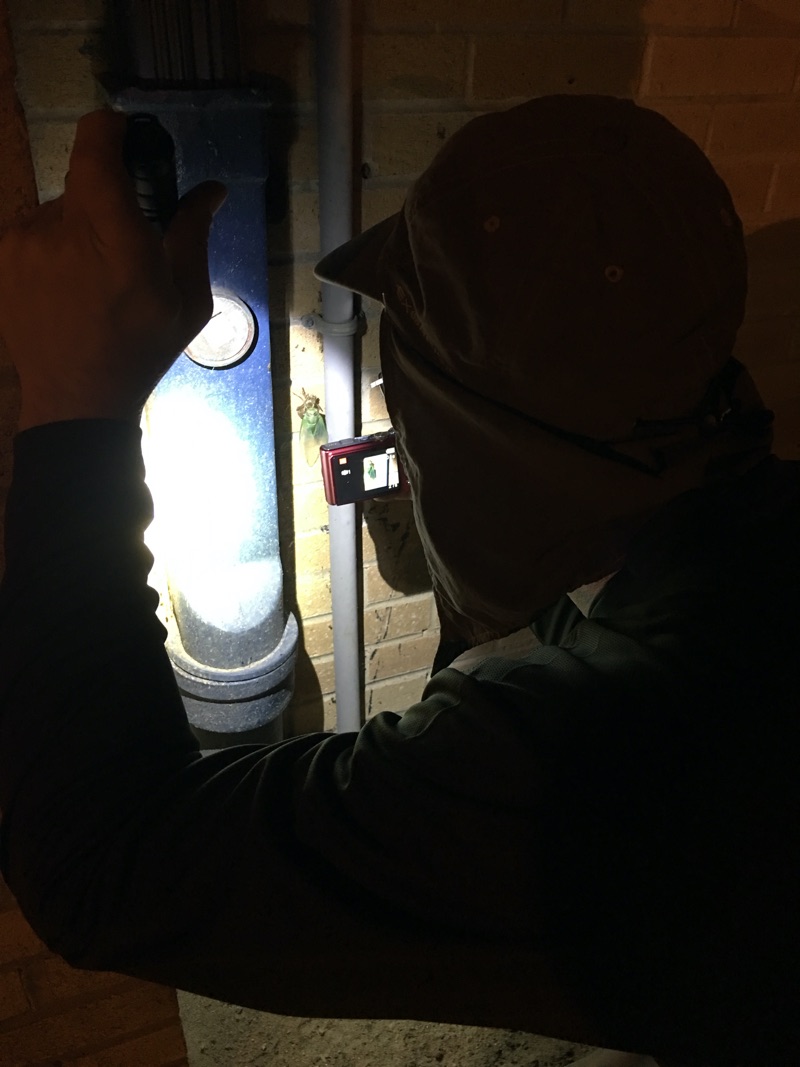
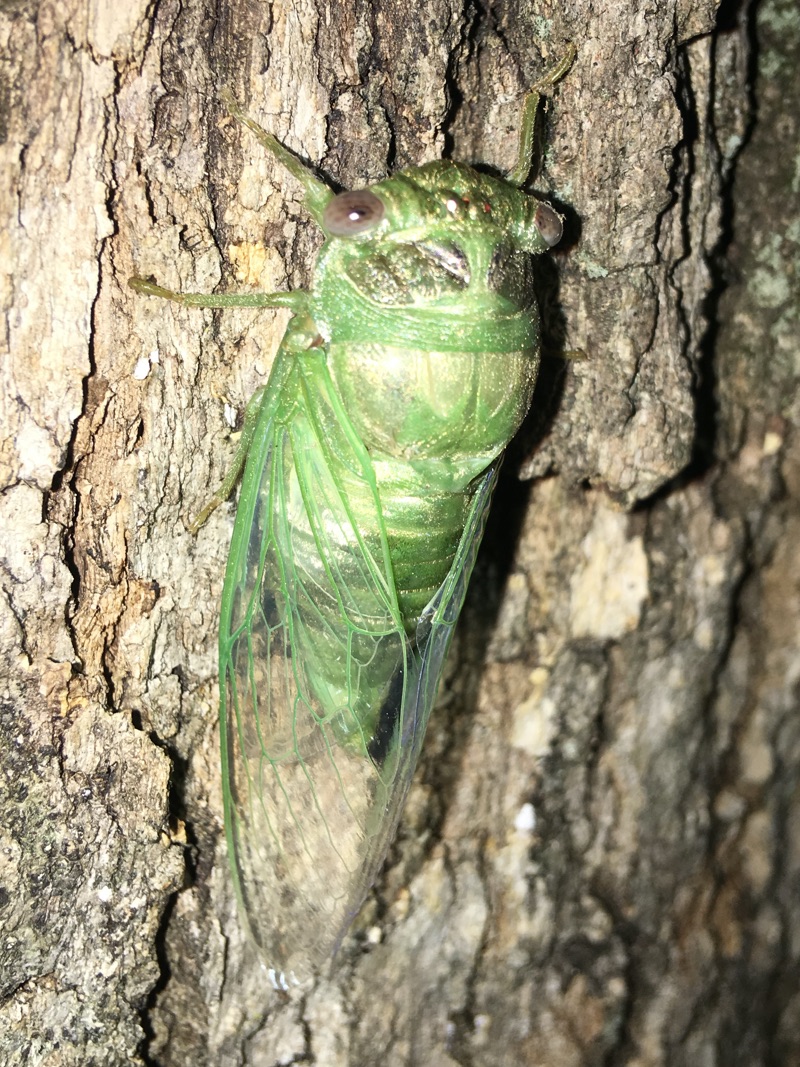
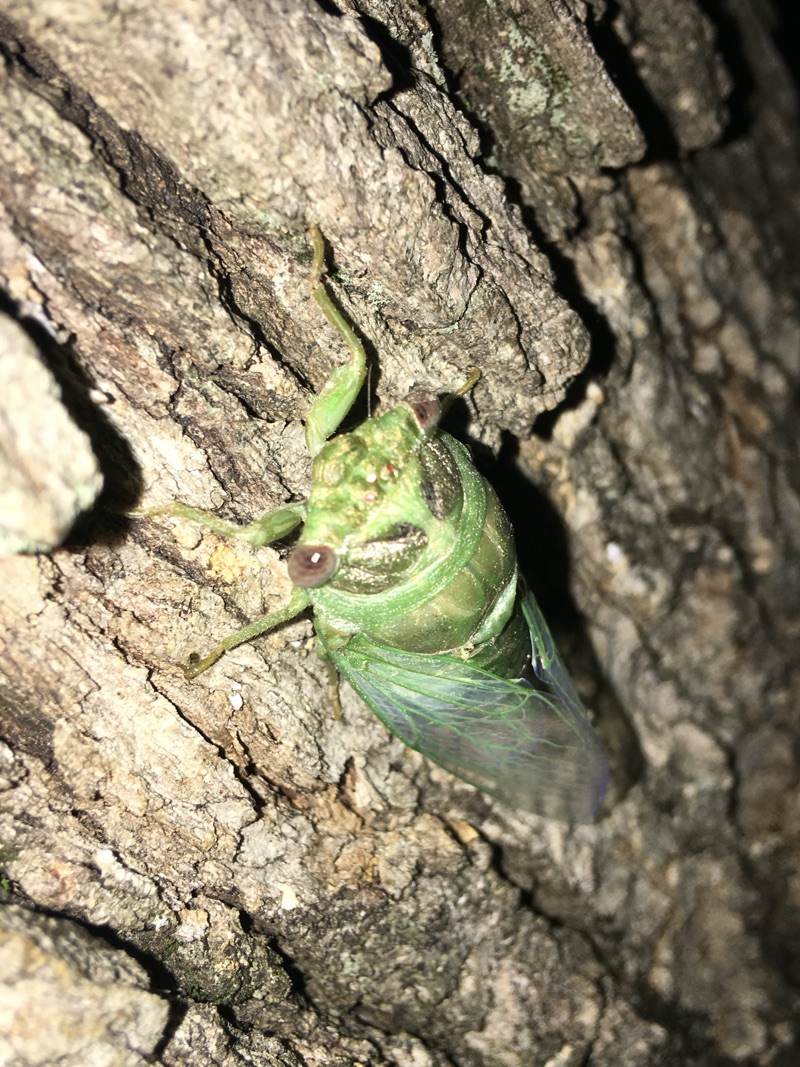
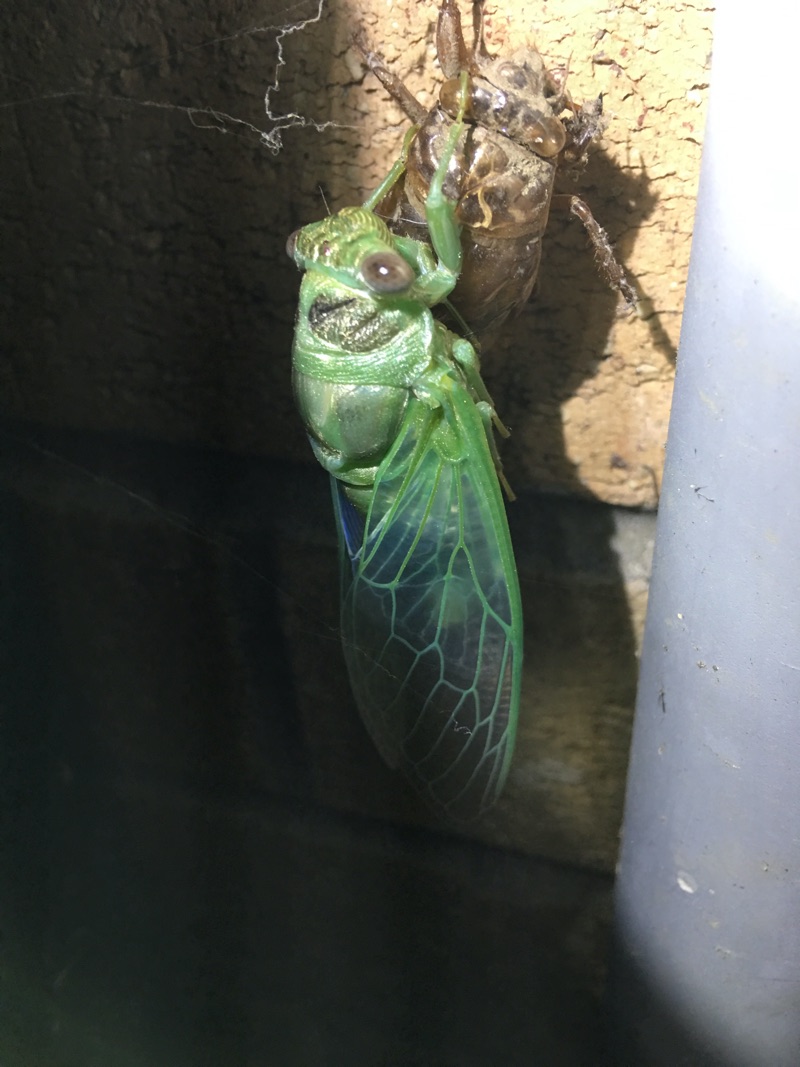
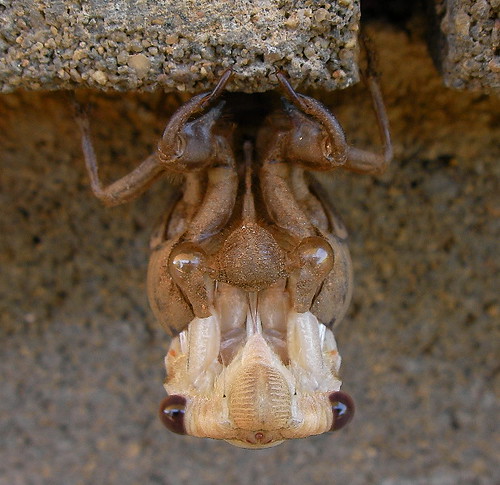
Archive of Annual Cicada Sightings 2010
I admire your website and love it!!! Here in Brazil we see lots of cicadas everyday.
I posted here the link to my blog, where i do post every picture i take from cicadas here in Brazil. If i see a different cicada, a take several pics (and sometimes a videoshoot) and make a very detailed record of its features, including the song.
I wish you could publish the link to my blog (sorry but it’s in portuguese, but people can comment in english).
thanck you!!!
Comment by Franco — December 19, 2010 [AT] 9:50 am
Finally the big ones are out with loads of ‘red eyes’ (see Flickr) and green grocers/ morphs along the coast and around Canberra (around 10 species). A trip in western NSW over 4 days netted 22 species (4 new) and expanded distributions of many rarer ones. We have been collecting flannel flower seeds for a PhD project in november/december and found quite a few cicadas in the safaris. I hope to post some to Dan shortly, including the lovely 10mm Urabunana sericeivitta from Gosford, where we also found black princes, yellowbellies, double drummers, Pauropsaltas annulata and fuscata, and a Cicadetta ticker.
Although the larger ones are making plenty of noise, there are only small emergences of little species around Sydney.
Comment by David Emery — December 13, 2010 [AT] 7:38 pm
Hello all,
With the current Cold front from up north, (Highs in the 50s and lows in the 30s), I think I have heard the last one a week ago for this year. It does get very cold — Freezing — in south florida.
Joe
Comment by Joe Green — December 8, 2010 [AT] 3:07 pm
Keep up the nice work David, and Joe, you are probably are one of the very few state-siders that still hears the cicada’s call. All insects here are pretty much gone. We wait patiently for northern spring!
Comment by Elias — November 28, 2010 [AT] 8:20 pm
Moderate emergences continue down under as the crazy wet/dry events keeep them low. Some hot waether last week heralded green grocers singing around Sydney (emerging around 2 weeks late). A 4-day run through western NSW yielded around 20 species (mostly 20mm body length) and linked distributions of speciemns from nothern and more southern areas. the species that seems to have benefitted from all the rain and grass growth is Cicadetta waterhousei that appears widespread in November. The Black Princes have emerged last week as well, so perhaps the larger species will follow in numbers. It’s not much of a season so far around Sydney and it’s raining again!
Comment by David Emery — November 28, 2010 [AT] 1:45 pm
Hello all,
Sorry for the long hiatus, but haven’t been doing much cicada work lately but wanted to let north americans know that Tibicen davisi’s are still calling in south florida, west of Miami, fla. Seem’s I heard more males today than last week calling from pine tree’s.
Great to read post’s about what’s happening down under, keep them coming.
Joe Green
Comment by Joe Green — November 17, 2010 [AT] 5:47 pm
Hi Naomi,
Probably you have a darker “yellow monday” that is pretty rare amongst colours of the GGs. As for the Aussie emergence around Sydney, the erratic cold and wet season has played havoc with the October species that have barely surfaced. ones that have, such as small squeakers and masked devil versions of the GGs have been silenced by the repeated rain. Some hot weather last weekend saw the double drummers coming out of their holes around 0830h in the morning and emerging on fences and trees en masse at Hawks Nest (like 4 years ago!). hope for some better finds in the next 2 weeks.
Comment by David E — November 15, 2010 [AT] 3:07 am
Hi. We have recently found an orange cicada that i think is a ‘red devil’. Are these rare? as i am used to seeing only the green grocer’s in victoria australia
Comment by Naomi — October 29, 2010 [AT] 12:51 pm
OK, the Aussie summer is underway with the first green grocers singing around western Sydney last night (12th October). One emerging GG was also posted on Flickr. The local bladder cicada population has reached at least 25 males and the smart large black and white birds (currawongs)are hanging about at dusk to catch the females flying in to the singing males. I have also heard 4 other species, but it is early days and more should emerge once this thunderstorm front moves through over the next 2 days.
Comment by David E — October 13, 2010 [AT] 2:50 am
Hello David,
Love the picture of the bladder cicada! Please send more pictures of other species! Dead quiet here in NY. I am going to follow the Australian cicadas now!!
Take care
Elias
Comment by Elias — September 17, 2010 [AT] 3:45 pm
No Elias- Lindsay’s is the best.
Comment by David Emery — September 12, 2010 [AT] 7:15 pm
Hello David. Found this site with the calls of Australian cicadas and pictures. http://sci-s03.bacs.uq.edu.au/ins-info/index.htm
Do you have any other sites to learn about these fascianting species?
Comment by Elias — September 12, 2010 [AT] 4:29 pm
The early guys are emerging in Sydney. Bladder cicadas (Cystosoma saundersi)and Cicadetta celis (silver princess) were heard on Sept 10.
Comment by David Emery — September 12, 2010 [AT] 3:43 pm
I have a captive T. davisi that is doing quite well in captivity. Today is day #16. The record is held by a captive T. auletes lasting 23 days in captivity. Wonder what the longest length of time a cicada has been kept in captivity?
Comment by Elias — September 12, 2010 [AT] 6:23 am
Hello David,
Time to turn the spotlight onto the Southern Hemisphere!!
New York has fallen silent. Northern cicada-maniacs will live vicariously through you.
-Elias
Comment by Elias — September 11, 2010 [AT] 9:09 am
Move aside all of you dying Tibicens– bladder cicadas are emerging down under for the start of the orchestral entertainment in the southern hemisphere!!
Comment by David E — September 7, 2010 [AT] 4:28 am
Sounds like a Tibicen tibicen aka chloromera aka Swamp Cicada.
Comment by Dan — August 28, 2010 [AT] 5:20 pm
I’ve run across a few very large, very loud cicadas in the St.George area of South Carolina in the last few days. (Southeast corner of intersection of I-26 and I-95). They are mostly black, with a little white on top with white bellies. As big as my thumb. I captured one in a jar this evening — frightening — and the dog is going crazy for them. The hundreds in the trees join into a wave of noise every few minutes.
Comment by Dimitri — August 28, 2010 [AT] 5:13 pm
Its Day 3 for the male Tibicen canicularis I have in captivity. It produced a week alarm squawk yesterday. Will see how long it can be kept alive.
Comment by Elias — August 23, 2010 [AT] 3:54 am
That is a Tibicen cicada.
Comment by Dan — August 19, 2010 [AT] 6:22 pm
Here is a link to pictures of what my husband and I think is a Cicada. We live in New York State. Does anyone know if this is actually a Cicada?
Comment by Sally B — August 19, 2010 [AT] 6:08 pm
Here in New York Tibicen linnei and Tibicen chloromera are still going strong. My captive auletes died 23 days post emergence. Another observation is that the Cicada killers appear to be finished early as no more adult females were seen by the lek in a nearby park. Not to long left to the Northern cicada season!
Comment by Elias — August 16, 2010 [AT] 3:58 am
Aug 14, 6:30pm. We are having a large swarm flying Round our yard now(50-100) south of Rock Falls, IL.
Comment by Kim — August 14, 2010 [AT] 4:56 pm
Hello Steve,
Great to see your shared enthusiasm for this remarkable insect. T. auletes is my favorite species. IF you can find a male eclosing and rear it in captivity, it will provide you with tons of entertainment. Have one that is 15 days old now.
Caught some stragglers from Brood II last year. Only Magicicada septendecim. I believe cassini and septendecula may be mixed in.
I am going to travel to see Brood XIX. It would be my first contact with the thirteen year species.
Comment by Elias — August 6, 2010 [AT] 3:28 pm
Elias, our main species here in eastern Kansas and Western Missouri are T.Pruinosa, T.Walkeri and T. Auletes. I have heard T.Chloromera and T.Canicularis and we have quite a few T.Dorsatus in the open areas around here.
I’m curious to see what happens with brood XIX next year as we are to have a decent brood right up to western Missouri, pretty close to Kansas City. We had an emergence of about 15-20 Periodicals in early June this year which were from brood IV due here in 2015. It was a rather large number as far as stragglers go. They were all in a small area as well. They were M. Cassini’s so maybe we will see an early emergence here. Should be interesting to say the least. I will try and take some pictures if we get a decent number of Tibicen emerging again tonight. My kids are fascinated with them and I guess I am too 😉
Comment by Steve — August 6, 2010 [AT] 7:14 am
Nice job Steve! We here in the North East never get to see such large #’s of cicadas except (Periodical Cicada emergences). What other species do you have by you? Kansas is particularly blessed. Here is a great paper on the biology of Kansas cicadas. http://entnemdept.ufl.edu/walker/buzz/c700lb28.pdf
Comment by Elias — August 6, 2010 [AT] 3:50 am
Got home from school tonight and found no less than 17 emerging Tibicen on 2 trees in my back yard. Looks like about ten of them are Tibicen Marginalis(Walkeri)several Tibicen Pruinosus and 2 Tibicen Auletes. The last 3 nights here in Kansas City have been pretty incredible. Averaging about 10-20 a night. Have a good mix of the 3 species singing right in the backyard each day and evening.
Comment by Steve — August 5, 2010 [AT] 8:25 pm
257 Comments
Went light collecting in New Jersey again — recovered 3 T. lyricen females. 88 degrees F (31 deg C) yesterday at night. No neocicada or auletes. First auletes eclosing was recovered 7/22. That was a beautiful sight. Waited many years to see that!!
Comment by Elias — July 25, 2010 [AT] 6:49 am
Went to Lakewood NJ yesterday. The light hunting technique finally worked! Captured 2 Neocicada hieroglyphica and 1 Tibicen lyricen male that flew to a ground based bright lighting system. Temperature was around 80 degrees (F) (27 deg C). Heard a fast tempo T. auletes call which was much faster than the others that called at the usual slow tempo. Also heard Tibicen chloromera, a species I never heard in the pine barrens before.
Comment by Elias — July 18, 2010 [AT] 6:21 am
Yes Joe — Still have to catch my 1st nymph!! have a bunch of days off so will have some fun now! Good luck down in FL.
Comment by Elias — July 16, 2010 [AT] 8:03 pm
JULY,
is cicada season, all over the USA, It seems they started to call early due to the hot weather and dry conditions here.
joe
Comment by Joe Green — July 15, 2010 [AT] 4:06 pm
Hello all,
Cicada season has started in NY. Heard Tibicen lyricen and Tibicen chloromera calling. No exuvia found yet. Last year it was July 14th that I found the first nymph and a little later before I actually heard one.
Great to hear from you Joe — will let you know when I make it down to West Palm. Hopefully will do it soon!!
Comment by Dan — July 2, 2010 [AT] 5:54 pm
Elias,
So far D. viridifascia has been diffacult to catch, most are high up in tree’s to carch. Some that sound low, they seem to shut-up when approched which makes for a quik get away before I spot him.
Let me know if or when your in west palm — July and Augest is good months here.
Comment by Joe Green — July 2, 2010 [AT] 1:33 pm
I live near Nashville and recall a HUGE emergence in 1994 (maybe 1995??), but can’t seem to find any record of it and that year doesn’t fit the published brood cycles. Anyone else with me on that?
Comment by CKintheMJ — July 2, 2010 [AT] 12:05 pm
Hello Joe,
At some point have to get down to West Palm. I have heard diceroprocta viridifascia and olympusa last year. Never saw a live specimen or exuvia/nymph.
I have a week off coming in June — will have to do an Okanagana expedition then. Will keep you posted. Cant believe cicada season is here already! Felt like it snuck up on me!
Elias
Comment by Elias — June 3, 2010 [AT] 4:36 am
Elis,
I hear more when I travel inland from the coastlal region (Western side of Florida heading toward Lake Okachobee. More hieroglyphica’s, the most I can recall ever here In the city limits this early. Time to begin hunting and good luck on those Okanagana’s, keep us posted .
Joe
Comment by Joe Green — June 1, 2010 [AT] 3:35 pm
Hello Joe,
Watched your video. Firmly cements D. olympusa’s call in my brain. Have to start getting stuff together for some hunts this year. Hoping to see/catch Okanagana this year. I know the feeling about work — so tired from this weekend but got a 5 day Memorial Day vacation coming up!
Comment by Elias — May 24, 2010 [AT] 7:15 pm
Elias,
I can only assume that the abundant calls on N. hieroglyphica means its a good year for cicada’s, more than previous years. This weekend while working I heard Dicroprocta olympusa calling in Lehigh Acres, florida from pine tree’s. So I think, I’ll get my gear ready to collect some 2010 specimens, however I’m getting tired of work spoiling my weekend hunts like this weekend.
Comment by Joe Green — May 24, 2010 [AT] 4:06 pm
Hello Joe,
Yes — did hear them in July in central NJ. Do they go to lights too? That may be my one chance to get them. The summer was so cold last year that light collecting produced 2 T. chloromera, 1 T. lyricen and 1 T. auletes (first specimen). If Spring helps predict summer this should be good. Will keep you thoroughly updated. It was nice hearing cicada calls so early in Florida.
Comment by Elias — May 24, 2010 [AT] 12:42 am
Elis,
Keep looking and listning around your area, june — August would be a good time to search in your area. I’d say the best calling time is mid day to evening the hottest part of the day, even though thay call from Dawn to Dusk, this is the time period I hear more of them calling. I’ve noticed that at chico’s today not many were calling at 2:00pm, I wonder if the males have mated with females and died off???
Comment by Joe Green — May 22, 2010 [AT] 5:09 pm
Hello Joe,
Specimens of Neocicada have been reported at the eastern end of Long Island about 100 years ago. Need to get out there this June and confirm those data points. Would be very interesting if i can find them!!
Comment by Elias — May 22, 2010 [AT] 2:34 pm
Elias,
I’m glad you have them that far north, Sanborn says thay range to that area north and as far west as Arkansas/Texas south down into mexico. Remember the one’s you heard in orlando are varation johanns, and those in New jersey are N. hieroglyphica regular species here in the US. I don’t know any spacific’s but they sound the same in calling song.
Hopefuly we can communica more later.
Joe
Comment by Joe Green — May 19, 2010 [AT] 4:53 pm
Thank you Joe for your thorough and informative response. I have located neocicada in mid New Jersey. Also Davis places there most Northern range at the end of Long Island. I will have to invstigate this year. I hope to capture a specimen from NJ in addition to getting some more Auletes. Cant seem to get enough of that species!!
Comment by Elias — May 18, 2010 [AT] 1:17 pm
Hello Mark,
The Percey Prist Lake area is a good place to find cicada’s, lots of land and parks. Glad to hear there are stragglers 1-year early in that area as I’ll be there next year for the big explosion next year in 2011. Its the great 13 year brood that I’ll be conducting work in Georgia, Alabama, Tenneessee and maybe the Carolina’s. I understand that there are large locations located in sections of those states. Most magicicada’s have a resting period before heading to the tree’s for mateing higher up, some of them like to conduct business down low however.
joe
Comment by Joe Green — May 17, 2010 [AT] 5:49 pm
Hello Elias,
Neo hieroglyphica shells and nymph’s are small, they are a medium sized cicada when they turn to adults. Only when I get lucky do I find a nymph only on a tree. They have a uncanny ability to know when you are there, because I find them stopped on the tree (Not moving like Tibicen’s or magicada’s do when approched) not knowing if they are anchored for molt, I not the place & tree, then come back in a few minutes only to find the nymph has move farther up the tree, and yes its stopped not moving when I spot him. I find them mostely in the molting process and just a magicicada’s (White) they are easy to spot neocicada (Light green). I have found molting one’s in the morning, noon, evening and dusk but more of them at dusk time just before it gets dark. Exuvia-you must look close on the tree’s, I’ve found their molts on grass, sticks laying on the ground, base’s of the trunks of tree’s to as high up as 10 feet high in the tree. Best thing i can say is take your time when looking, I’ve found more on the ground than on trees. As far as catching them goes, I’ve had more fun with a net because sometime’s you have to figure out how to position the net in the best way to capture the adult cicada if there’s not to many limbs, leaves or stuff to do so. Otherwise you must dislodge the cicada from the present perch to a new location if you can follow the flight path. Maybe you can catch him. If you find large aggrations of calling males it is possable to catch them by hand without a net if they are low to the ground, otherwise your going to need a good pair of Binocolars to spot them on the limbs.
Joe
Comment by Joe Green — May 17, 2010 [AT] 5:20 pm
Heard Neocicada hieroglyphica call in the trees in the back parking lot of the Hilton Hotel on Buena Vista drive, Orlando, Florida. I was unable to locate exuvia or nymphs. Probably Joe Green would be the best equipped to answer this question — what is the best way to capture an adult specimen in addition to nymphs/exuvia?
Comment by Elias — May 14, 2010 [AT] 9:49 pm
Went out to feed the birds and noticed cicada shells everywhere. As I looked down I saw them in the grass also. Upon closer inspection I saw the insects and they appear to be the Magicicada that I have seen posted. There were dozens just sitting everywhere.. so I guess they are drying out. We live in the Priest Lake area of Nashville.
Comment by Mark — May 12, 2010 [AT] 6:08 am
Since 4/24/2010 there has been a incress in numbers of Neocicada hieroglyphia’s here in south florida. I have been keeping a emergance log of this species for 6 years now and they uselly start out slow and I don’t heard large numbers until June. This week, large groups (Dozens) calling from Oak tree’s at work. My friends are also reporting hearing them from other parts of the area. I’m going to a few sites to check out whats happening with my camera and camrecorder ready.
Thanks, Joe
Comment by Joe Green — May 9, 2010 [AT] 7:00 am
We’ve seen a few today in Brentwood, TN — – YUCK
Comment by erin — May 8, 2010 [AT] 1:32 pm
Randall, the ones that are out now are stragglers, emerging a year early. If you like, submit your sighting to magicicada.org and they’ll put it on their map.
Comment by Dan — May 8, 2010 [AT] 9:47 am
in Nashville. We noted this weekend the emergence of what appears to be 13-year cicada. I have lived here for the last two emergence in 1985 and 1998.
They are not due again till 2011! Isn’t this about a year and a month early?
We have had a recent flood (15 inches in two days) last weekend. Would that cause an early emergence?
Comment by Randall — May 8, 2010 [AT] 9:05 am
I know it is late in the season, are cicadas still active in Australia?
Comment by Elias — March 30, 2010 [AT] 9:06 am
Hi Helen,
It IS a great year for the big cicadas around NSW except for the riverina. If rain holds off, they should start diminishing by late January. They ARE excellent perch (bass) bait, although the “crazy crawler” lures that flop across the surface like cicadas are sure-fire as well.
David
Comment by David E — January 11, 2010 [AT] 7:40 pm
Do you know where can I purchase some cicadas? Please send me any information that you can to my email directly. Thank you for your help in advance.
Fred
fsharp [AT] egacc.com
Comment by Fred — January 11, 2010 [AT] 3:05 am